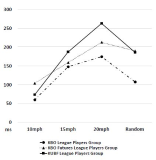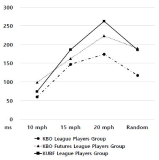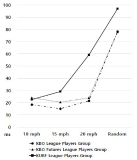This study aimed to explore elite taekwondo competitors’ imagery strategies . The study participants were 10 elite taekwondo athletes, who worked for S business team. Data were collected through open-ended questionnaires and in-depth interviews. The data were collected based on Gould et al. (1992)’s proposed qualitative research method. The inductive content analysis of the imagery was conducted following the imagery type of Paivio (1985) and Suinn (1996). The law data and case of imagery were separated by three specialists. The results were as follows. First, elite taekwondo competitors generally used the types of imagery proposed by Paivio (1985) and Suinn (1996). In particular, imagery of anxiety regulation appeared with the highest frequency among factors and ordered imagery of motivation, imagery of skills, imagery of mental skills, and imagery of competition. Second, elite taekwondo competitors mainly used imagery of skills before two weeks for competition. They mainly used imagery of anxiety regulation the day before a competition. They used imagery of anxiety regulation and imagery of motivation on the day of a competition. They used imagery of motivation after the competition. In sum, elite taekwondo competitors used individual strategies in terms of imagery in order to ensure effective training and peak performance in competition. The strategy of imagery was applied differently based on the juncture of the competition.
PURPOSE Since the COVID-19 pandemic, the demand for home training, with exercises or workouts at home, has steadily increased. As a result, the popularity of home training YouTube content, which shows how to use exercise equipment or workouts without professional influence, has also increased. Therefore, this study focused on the characteristics of YouTube home training content (specialization, diversity, and interaction), personal health awareness, exercise awareness, and expectation-confirmation model to identify which required exercise continuation intention through YouTube home training. METHODS SPSS and AMOS software were used to conduct frequency, reliability, and confirmatory factor analyses, as well as to conduct correlation analysis and construct a structural equation model. RESULTS First, health and exercise awareness had a positive effect on confirmation. Second, among the characteristics of home training content, only specialization had a positive effect on perceived usefulness. Third, confirmation had a positive effect on perceived usefulness and viewing satisfaction, perceived usefulness had a positive effect on viewing satisfaction and exercise continuation intention, and viewing satisfaction had a positive effect on exercise continuation intention, which proved the expectation-confirmation model in this study. CONCLUSIONS To increase exercise continuation intention through home training YouTube content, creators need to produce professional content that can stimulate viewers' internal motivation.
PURPOSE Taekwon gymnastics is expected to be a program that can overcome the management difficulties currently faced by Taekwondo gyms and contribute to the expansion of Taekwondo base. Therefore, this study aimed to examine the relationship among organizational identification, flow experience, intention to continue participation, and recommendation intention of Taekwon gymnastics participants. METHODS In this study, data was collected from 313 teenagers participating in Taekwon gymnastics at Taekwondo gyms in the metropolitan area from September 10 to 24, 2021. A total of 267 questionnaires were selected as the final sample, and data analysis was conducted using SPSS 23.0 and AMOS 23.0. RESULTS Organizational identification had a significant effect on flow experience, challenge only had a positive effect on intention to continue participation, flow experience did not significantly affect recommendation intention, and intention to continue participation had a significant effect on recommendation intention. CONCLUSIONS The results of this study confirmed that organizational identification can contribute to improving inner pleasure and self-esteem, and it is necessary to examine the role of factors that can mediate the relationship between flow experience and behavioral intention in the future. Furthermore, managers of Taekwondo gyms should hold various events that can inspire teenagers’ sense of challenge to encourage intention to continue participation.
PURPOSE This study aimed (1) to analyze the behavioral intention and use behavior among the consumers of online home training contents via YouTube by employing the unified theory of acceptance and use of technology (UTAUT); (2) to test the moderating effects of risk perception toward the coronavirus (COVID-19) infection, and 3) to test differential impacts of generational difference across millennial and baby boom generations. METHODS A total of 400 questionnaires were distributed, and 383 samples were used for the final analysis after excluding 17 incomplete responses. Data were analyzed using the SPSS 25.0 and AMOS 22.0. RESULTS It was found that (1) the performance expectancy, the effort expectancy, and the social influence had positive effects on behavioral intention; (2)the facilitating condition had negative effects on the use behavior; (3) the behavioral intention had positive impact on the use behavior. Moreover, the risk perception toward the COVID-19 infection did not have moderating impacts on the UTAUT model, whereas generational differences did. CONCLUSIONS Our results suggest that the marketing strategy that improves exercise performance, convenience, and social influencing factors may be key to home training customers' behavioral intention and use behavior. Furthermore, home training material makers should recognize that the features and infrastructure required for the two generations are distinct and develop a separate marketing strategy for each.
PURPOSE The purpose of this study was to apply a life skills program to student-athletes and statistically verify the changes in life skills of the experimental and control group. METHODS Participants were 34 high school Taekwondo athletes (Mage=17.71). They were divided into 18 in the experimental group and 16 in the control group. For eight weeks, the experimental group participated in the life skills program after training and the control group participated in only training as usual. Data were collected by using Life Skills Scale for Student-Athletes (LSSSA), and the participants of two groups filled out the LSSSA before and after the program application. The collected data were analyzed by using repeated measure analysis of variance (ANOVA), and partial η2 (eta squared) was calculated to present the effect size. RESULTS The interaction between time and group was statistically significant in goal setting, coping with stress, positive thinking, and managing emotion among sub-factors of life skills. Partial η2 was interpreted as having a large effect size as it revealed the range of .22 to .51. Therefore, comparing before and after participating in the program, the life skills score of the experimental group among the two groups was significantly improved. CONCLUSIONS Student-athletes who participated in the program experienced positive changes in life skills than those who did not participate in the program.
PURPOSE This study aimed to develop a model for life skills transfer in sport. METHODS A literature review of research on life skills transfer was conducted. The prior representative studies on sport life skills and transfer models were selected and discussed to improve the validity of this study. RESULTS First, based on the basic psychological needs of the internalization and generalization of life skills, the model for life skills transfer should consider the influence of the explicit and implicit climate and environment. Furthermore, access to cognitive processes is required based on the conceptualization and integration of transfer. Second, the concept of a transfer was defined, and key issues of the cognitive processes that support the connection between the sport domain and out of the sport domain were discussed. Third, the model for life skills transfer in sport was presented. In this model, life skills transfer occur through sport context, cognitive process, promoting factors, and out of sport context. CONCLUSIONS Since the 2000s, research on life skills and transfer in sport has developed quantitatively based on positive youth development theory. Unfortunately, research on this area in South Korea is very insufficient. This study suggests a model for life skills transfer in sport based on an extensive and systematic analysis of the prior research, and this model can be used for future research.
PURPOSE This study was to examine safety awareness of sports among university students. METHODS Total 1950 university students of 9 regions responded to questionnaires on safety awareness of sports with using simple random sampling. The date were analyzed by frequency analysis and Two-way ANOVA. RESULTS The results of this study werew as follows: Fistly, male students were experienced safety awareness education more than female students. In addition, the education of safety awareness of sports took place in sports field, but most of students did not aware of safety personnel. Secondly, university students thought that sports was not safe because sports facilities and equipments were not managed and they were worn out. Thirdly, they perceived sports safety was managed generally normal. Furthermore, they perceived the aging of facilities and equipments at sports sites was major factor in the occurrence of safety accidents. In order to reduce sports safety accidents, it is necessary to facilitate safety education of sports at government. CONCLUSIONS The results of this study will be used as fundamental information to raise safety awareness in university students and to establish safe sports culture.
PURPOSE The purpose of this study is to examine the goalkeeper’s area of defense and how the range varies depending on the relative position of the goal, goalkeeper, and ball in a 9-meter jump shot during handball matches. METHODS Data was collected from seven qualifying divisions in mens handball from the 99th National Sports Festival in Korea. A total of 231, 9-meter jump shots were analyzed with the goalkeeper‘s area of defense measured from the point the ball left the shooter’s hand and calculated based on the relative position of the goal, goalkeeper, and ball. Video analysis was conducted using the Kwon3D 3.01 program and three-dimensional coordinates calculated using the DLT method. RESULTS First, dimension of handball goals measure 3m wide and 2m high, however, results show that goalkeeper’s actual area of defense was narrower than the width of the goal posts, while vertically, area exceeded the height of the cross bar. Second, if the goalkeeper defended the striker’s shot from the side rather than from the front, the goalkeeper’s defense range was higher for the opposite side of the goal post than the near side of the goal post. CONCLUSIONS Key factors influencing goalkeeper’s area of defense include height of shot and position of goalkeeper. Results also indicate that vertical movements are more important than horizontal movements for goalkeepers in handball thus such implementation in training may lead to performance enhancement.

Purpose The purpose of this study was to conduct a typological classification of female college students in sport studies regarding perceived career barriers. Methods Q-methodology was used to identify female college students’ viewpoints on carrier barriers. The Q sample was distilled from 76 statements (64 from literature reviews and 12 in-depth interviews) to 25 statement after conducting literature review, in-depth interviews and surveys with open-ended questions. The P sample for this study was 30 students around Seoul and PQmethod software was used for data analysis. Results Three distinct views were extracted: First type of ‘career opaque’, revealed that students have failed to find their own aptitude and interest. Second type of ‘sexual discrimination-male centered’, implied students’ concerns about discriminating factors in relation to marriage and pregnancy for the job they desire. Third type of ‘Insufficient experience and qualification’, indicates students perceive their lack of experience or qualification required for their career. Conclusions The identification of these three viewpoints could provide insights that can be used to design more segmented and detailed career policies for female college students in sport studies.


[Purpose] The purpose of this study was to investigate effects of baseball expertise and stimulus speeds on coincidence-anticipation timing accuracy of batting. [Methods] Participants were 21 baseball batters, 7 of Korea Baseball Organization(KBO) League, 7 of Korea Baseball Organization Futures League, and 7 of Korea University Baseball Federation(KUBF) League. All of the participants were asked to swing the bat exactly at the time when the light arrived the target point of the runway. The Bassin Anticipation Timer was used to present stimulus with stimulus speed of 10, 15, and 20mph. Participants performed 10, 15, 20mph trials (3 kinds of speed per 5 times) and random trials (3 kinds of speed per 3 times randomly). The timing error of coincidence anticipation task was recorded and raw scores were transformed to constant error(CE), absolute error(AE) and variable error(VE). For data analysis, two-way ANOVA with repeated measures were used. And post-hoc test (Tukey HDS) were conducted. [Results] Results indicated a significant interaction on expertise and stimulus speeds for CE, AE and VE. The KBO League players group showed more accurate and consistent performance than the KBO Futures League players group and the KUBF League players group in baseball batting timing. [Conclusion] This findings revealed that coincidence-anticipation timing accuracy batting in baseball can be used as a factor to distinguish the ability of the other.


